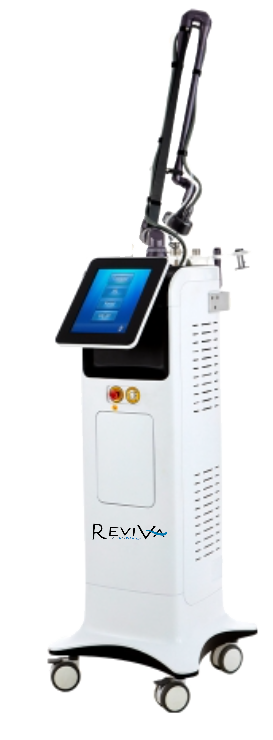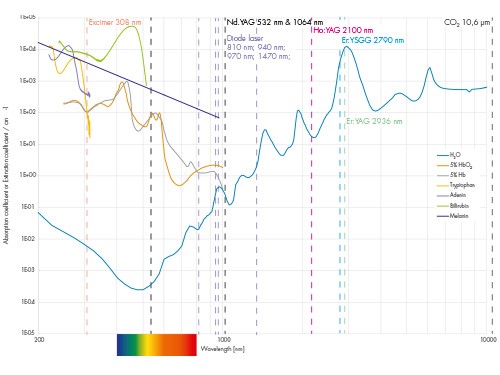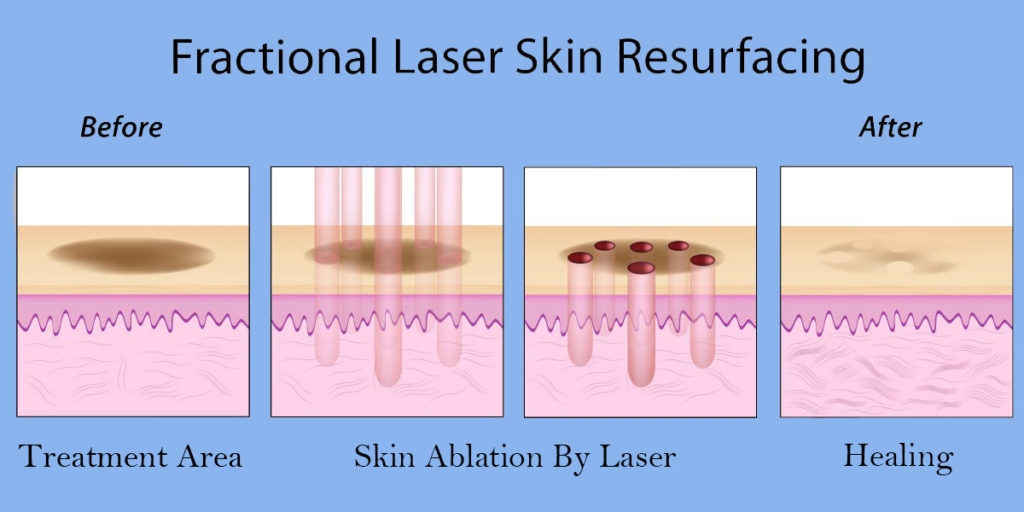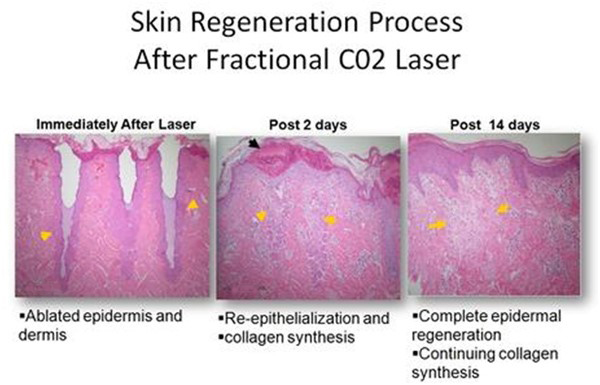-
Key Facts
-
Overview
-
Clinical Theory
-
Resurfacing
-
Questions
-
Comparison

ReviVa CO2
The ReviVa CO2 laser has the capability of facial resurfacing along with surgical and gynecological procedures. This fractional ablative laser technology has become the gold standard for creating youthful skin.
FRACTIONAL SKIN RESURFACING
- Fractional Resurfacing transforms the skin and can create a youthful look up to 15 years younger
- Reduces wrinkles
- Increases collagen
- Produces brand new skin cells for a more youthful appearance
- Fractional for increased healing and less down time
- Scanner Head with multiple patterns and sizes
- Surgical cutting and non-scanner ablation hand pieces
- In office training along with unlimited continual clinical support
SURGICAL CUTTING
Non-scanner ablation hand pieces also provided.
IN OFFICE ZOOM TRAINING
Hand piece and foot switch
Contact Us!




Overview
The ReviVa CO2 laser is one device that can cover all of your skin resurfacing needs. The ReviVa features Fractional facial resurfacing, non-scanner resurfacing, along with surgical cutting applications. The device has no consumables, so there are no hidden costs. The CO2 laser wavelength of 10,600nm is unparalleled for skin resurfacing. This wavelength has the perfect water absorption percentage for ablation and thermal depth penetration. No other laser can compare to CO2’s perfect resurfacing and ablative characteristics.
Fractional resurfacing allows providers to selectively resurface a certain percentage of the skin. This key benefit allows for faster healing and a more comfortable recovery process. The old days of full-face resurfacing required weeks of downtime. Providers can now manage the resurfacing coverage and control the recovery process. By fractionally resurfacing the skin, the tissue now heals from the sides, as well as from below. Resulting in little to no down time, while still maintaining the incredible results. The amount of fractionalization can be set by the operator to allow anywhere from 1 to 5 treatments. Treatments are usually 4 to 6 weeks apart.




Clinical Theory
The ReviVa’s 10,600nm wavelength absorbs into water in skin cells, which are filled with water, vaporizing the tissue utilizing controlled precision laser beams. When the body detects the skin cells are destroyed, your natural healing process will begin. New skin cells replace the damaged cells. Unlike other aesthetic procedures, the old skin cells are vaporized. New cells form to replace aging tissue in the treated area. Clients are assured youthful skin cells everywhere the ReviVa CO2 laser has treated.
In addition to creating beautiful youthful tissue, the thermal response will also shrink the collagen’s triple helix molecule. The shrunken collagen will tighten tissue while new collagen formation and healing will hold it into place. This is what makes ReviVa CO2 resurfacing the gold standard for a youthful facial transformation.
The new technique of fractionalizing the beams allows selective precision resurfacing instead of the entire epidermis being resurfaced. This innovative technology allows quicker healing time and a more comfortable recovery as tissue heals from the perimeters inward as well as from below. You can achieve the same result of full epidermal resurfacing with proper treatments regiments, without the discomfort and extreme downtime of the antiquated full epidermis procedure. The ReviVa’s Fractional technology makes treatment options available to clients that previously may not have considered resurfacing.


Resurfacing
The term “Resurfacing” is used to describe how a device, laser or otherwise, damages or removes the top layer of skin and the body would heal and generate a new layer of skin to replace the damaged or removed skin. Hence the term Resurfacing. This can be done mechanically like dermabrasion, chemically with chemical peels, or thermally with devices utilizing lasers, radio frequency, or plasma. Even though there are many methods of resurfacing, we will only be discussing the CO2 laser method as it is the most popular and effective.
To resurface skin utilizing lasers, you must pick an absorbing chromophore as the target. Since skin cells are like tiny water balloons, one must use a laser wavelength that absorbs into water. The percentage of light that is absorbed into water is very important and it is determined by the wavelength of light. The more light that is absorbed by water, the higher the temperature of the skin cell and the less depth penetration of the light. Lets use 3 lasers as examples. The diode laser at 1470nm, the Er:YAG laser at 2940nm, and the CO2 laser at 10,600nm. These lasers water absorption percentage are shown in the graph below.
The graph shows absorption in water as a function of wavelength. The higher the absorption, the less depth penetration of the laser and thermal damage. As an example, Erbium laser at 2940nm has extremely high water absorption and no thermal depth penetration. It will resurface the very small top layer of skin, but does not have depth penetration for collagen shrinkage. The 1470nm diode laser has lower water absorption. This laser will cause thermal dame to a greater depth, but will not vaporize skin cells and cause ablation. The CO2 laser at 10,600nm has the perfect amount of water absorption to cause ablation to the top layer of skin cells, while also allowing enough energy for deeper thermal damage and collagen shrinkage. It possesses the perfect balance for ablation and deep collagen remodeling.


Questions
Q: Is the procedure painful?
A: The procedure requires a topical anesthetic or injectable anesthetic. The patient will feel no discomfort during the procedure. After the treatment and the anesthetic subsides, the patient will feel like he/she has a sunburn which will last for about 3 to 4 hours.
Q: How many treatments do I need?
A: The amount of treatments required will be 1-5 depending on the amount of skin damage you possess and desired down time. This device can treat 20% – 50% of the skin at one treatment. The more aggressive the treatment, the better the result and longer the downtime. The patient can choose 5 mild treatments with little downtime, or 1 – 2 aggressive treatments with longer downtime.
Q: What is the approximate downtime?
A: The downtime ranges from 5 to 14 days depending on the aggressiveness of the treatment. You can discuss the option with your provider.
Q: How long do the results last?
A: The results are from removing the skin cells and the body replacing them, so they are permanent. However, permanent does not mean it will stay forever just as we do not stay 25 years old forever. Time marches on and the skin and collagen will age at their natural rate. Most people choose to have a full series done every 3-5 years, but it can be done much sooner if desired. Single low power maintenance treatments can be performed every 4 months if desired.
Q: Can anyone be treated?
A: Only Fitzpatrick skin types 1-3 can be treated. Unfortunately darker skin types have a high risk of hyperpigmentation and must be avoided.
Q: Can the body be treated, or just the face?
A: The CO2 can be used on most parts of the body, however, the power settings must be lowered to avoid complications.


Comparison
The beneficial effects of fractional ablative resurfacing are due to the healing process from the controlled damage that is inflicted. When the skin cells are destroyed and thermal damage is created, the body will grow brand new skin cells and tissue as well as release growth factors that will cause the fibroblasts to create new collagen and also grow new micro vessels. This new growth is what creates more youthful skin and connective tissue. One can see the wound channels immediately after fractional CO2 laser in Figure 3. First notice the ablation region (the region closest to the skin surface that has no tissue) which has fully ablated all the skin cells. Second, notice the non-ablated region (the region below the ablated region which contains thermally damaged skin cells) which contains skin cells and tissue, but is thermally damaged. The unique water absorbing characteristic of the CO2 allows a large ablated depth along with a large non-ablative depth. This makes for a perfect combination of both. An Er:YAG laser which has an extremely high water absorption characteristic will have a very shallow ablative region and almost no non-ablative region below the ablative region. The result of the Er:YAG is a superficial treatment with less beneficial results. The 1470nm diode laser which has the lowest water absorption characteristics will have no ablative region, and only a non-ablative region. Since there is no ablative region, the skin cells will not be completely replaced as some non-damaged tissue still exists in the area. The result of both these lasers is a less impressive result than that of the CO2 laser. The healing of the epidermis and collagen formation can also be seen in Figure 3. Since fractional ablation allows healing from the sides as well as below, you can see the ablation region is already filled in by day 2 along with the beginning of collagen synthesis. By day 14 you can see complete epidermis regeneration and continued collagen synthesis. The clinical result is brand new skin with a more youthful plump healthy look.
We Supply Everything You Need
ZianMed offers all the essentials so you can
start enjoying your new product.
We are always available to assist you in finding the perfect solution.


Purchase Plans
Low financing rates available.


Rental Program
Monthly rates with no commitment.


Contact Us
Visit our contact page.


Customer Service
24/7 customer service.
